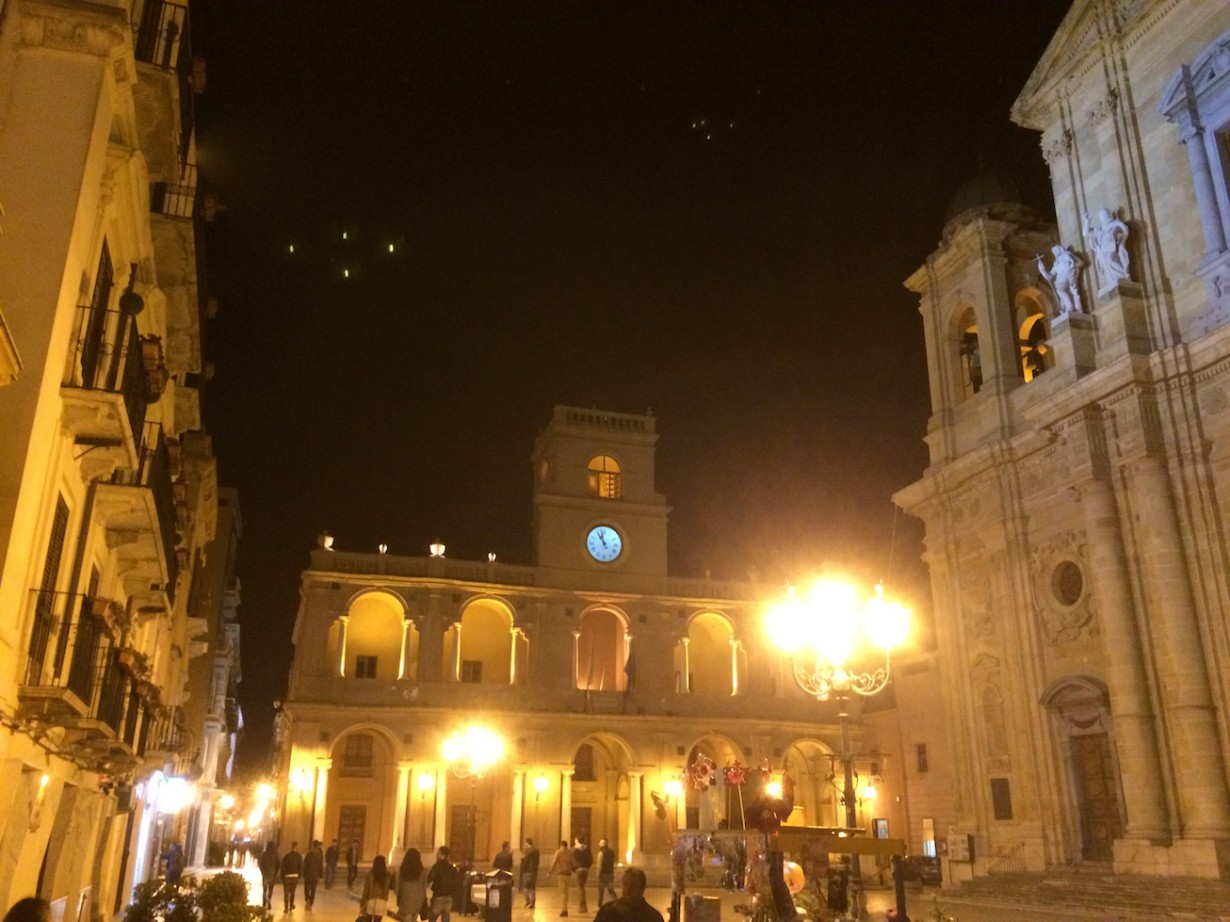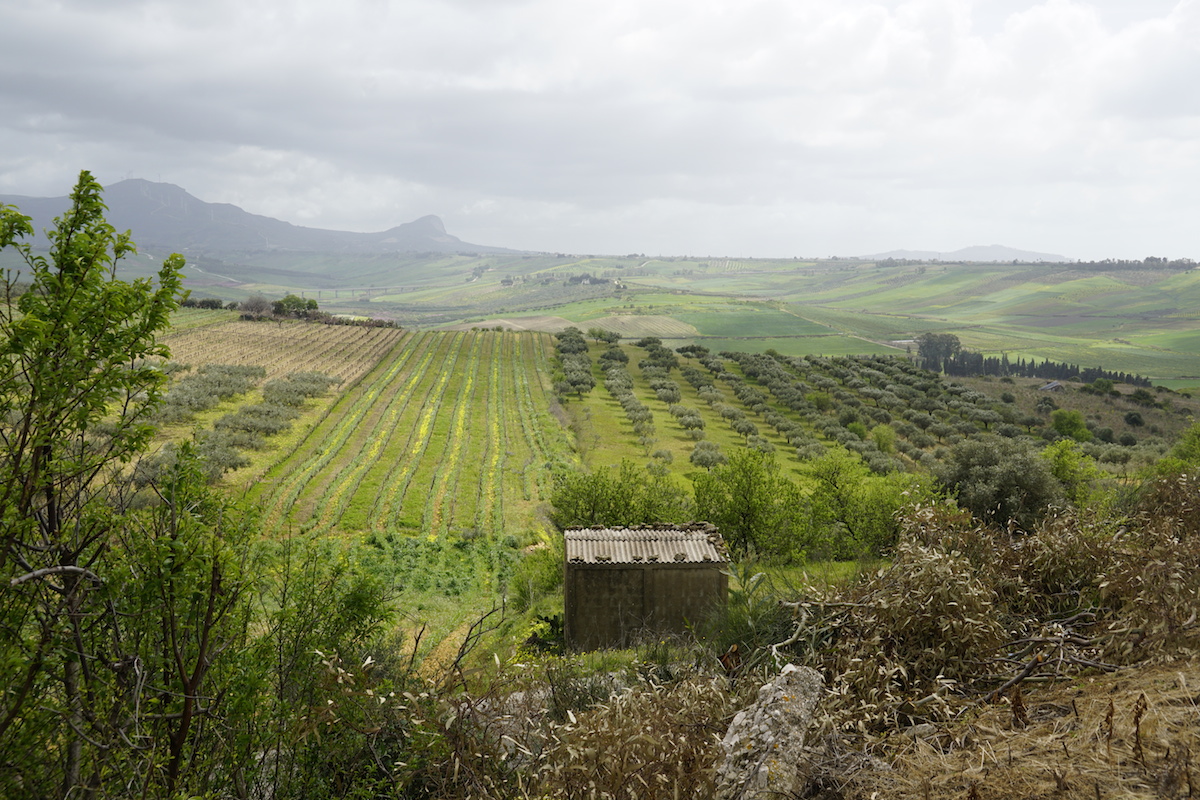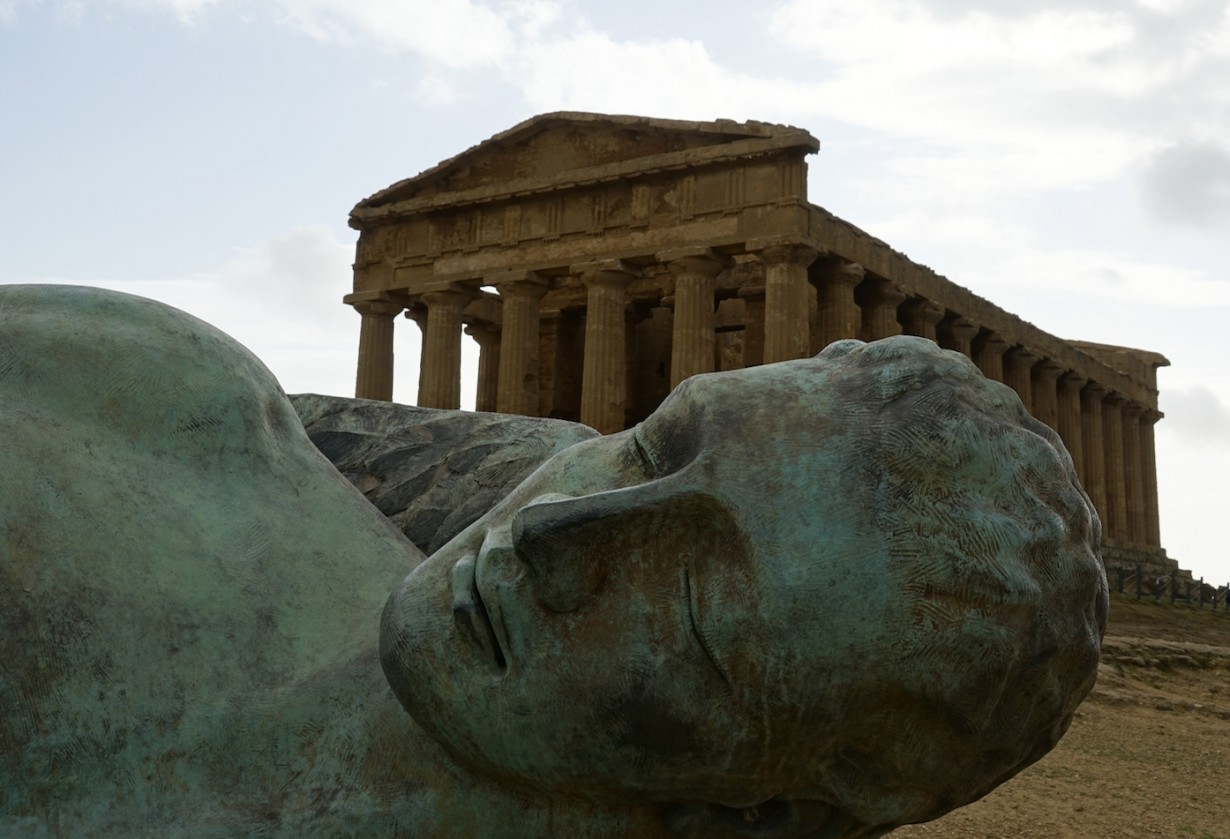
The marble walkways gleamed in the near empty streets of the old Arabic city of Marsala, Sicily. The main square Piazza della Repubblica was quiet and the silhouette of the Baroque facade of the Church of Purgatory was bathed in soft lights and made for an ethereal sight to begin our Easter vacation in Sicily. We enjoyed the spectacle of some trendy bars buzzing with pheromone mating rituals but opted instead for a quiet enoteca to indulge in a few glasses of the famed wine from the Marsala region. We met some friends from Bregenz for a midnight tasting and sipped our way through a fruity 2012 Caruso & Minini Sachia Perricone and downed a plate of local salami and crusty bread. The next morning we toured the inner city and learned a bit of the history of the old town whose name derives from the Arabic “Marsa Allah” or Port of God. The city dates from 369 BC and has been an important trading port as well as a strategic stronghold into North Africa. It has been besieged and invaded by Arabs, Romans, Carthaginians, Vandals and much later in 1773 the English appeared on the scene, fortunately not to invade, but to make wine. After admiring the Duomo, we set off to explore the salt flat estuary and the windswept coastline that’s paradise for windsurfers and sailors before heading to our next night’s destination of Agrigento via Sciacca.
http://www.italyheaven.co.uk/sicily/marsala.html
Orange trees grow everywhere in Sicily. This iconic symbol of the island was brought by the Arabs in IX-XI century A.D. and their citrusy magnificence grace the hillsides. The Mediterranean landscape is similar to California with the same coastal brush and succulents, especially the prolific euphorbias that thrive in the warm climate. Sicily is essentially a bread basket disguised as an island. The earth is so fertile that wild asparagus, fennel, and artichokes sprout up right alongside the road and the fields abound with tomatoes, capers, and eggplant. The rolling hills are lined with rows upon rows of fruit trees laden with succulent oranges, almonds, and olives that follow the lay of the land. The culmination of the bountiful harvest is displayed in the produce markets that are a feast for the eyes and the day’s abundance is impossible to resist. It’s no wonder that Sicily is famed for its cuisine. The best fresh produce and seafood combined with the influences from North Africa and Spain make for the most delectable food combinations that it’s simply a foodie paradise.

But it gets even better. Those resourceful Sicilians have taken all that earthy goodness and sunshine and perfected their winemaking art and bottled it up into the aromatic Sicilian wines that we partook of with great pleasure. We tasted our way from Marsala to Palermo and reveled in the delights of the fermented fruit and offered our thanks to those long ago Mycenaean traders who introduced the drink of the gods for us mere mortals to enjoy. The local wines we savored were the Nero D’Avola made from the oldest indigenous grape, the Syrah that thrives in the hot climate, and the Etna Rosso, a gift that arose from the volcanic ashes of Mt. Etna.
http://www.nytimes.com/2013/08/14/dining/reviews/from-sicily-reds-worth-the-hunt.html?pagewanted=all&_r=0
The parking lot vibe of the port city of Sciacca emanated an authenticity to the historic fishing harbor. A few benches lined the lot and were presided over by small clusters of beret clad older men who most probably occupied those benches on a daily basis. The town is a bit like these old men, well worn yet fully authentic. Tourism has overlooked Sciacca although it earlier had been an important fishing and trading port for Greek and North African traders, and it was famed for its Roman thermal spas that date from the 7th century. Fishing still remains the dominant industry as do the sulfur spring baths. After rambling about for a few hours we enjoyed a lip smacking fish lunch and took in the panoramic views then set off for Agrigento for the evening.
http://www.italyheaven.co.uk/sicily/sciacca.html

The scirocco winds swept over the rows of Doric temples that dominate the summit of the famous UNESCO site of the Valley of the Temples in Agrigento. The early spring sunshine made it easy to forget that it was only the first week of April but the relentless gales reminded us that winter was hard to shake off as we huddled further into our jackets. The hilltop archaeological park dates from 510 B.C to 430 BC and is comprised of: the Temple of Hera, The Temple of Concordia, the Temple of Heracles, The Temple of Olympian Zeus, the Temple of Castor and Pollux, the Temple of Hephaestos, the Temple of Demeter, and the Temple of Asclepius. The original city Akragas, now Agrigento, was built by those handy Greeks who came from Rhodes and Crete and colonized the valley on the banks of the Akragas River. As we hiked about the ruins we admired the commanding view and the handiwork of these early builders. We were also surprised at the incredible shape that the site had been restored to. These temples were in better condition than what we’ve seen in Greece with the exception of the Acropolis. One particular piece of sculpture that stood out “head to toe” was a massive winged statue that lay resting on its side as if he were sleeping. And this beauty looked as if it had been dozing for many eons. But it wasn’t. This bronze sculpture was a recent edition to the site in 2011 by the famed artist Igor Mitoraj and was aptly named Ikaro Crashed. The sculpture represents the story of the unfortunate Icarus from Greek legend who in his quest to fly from Crete using his wings made from wax flew too near to the sun thus melting the wax and he plunged tragically to earth. So much for reaching for the heavens. Nevertheless, the site specific sculpture “theme of failure at the hands of hubris” exuded the strength and beauty of the ancient Greek culture.
http://www.sacred-destinations.com/italy/agrigento-temples
Caution Catania
Ahhh Catania. What can I say about this city in the Mediterranean infamous for its Mafia connections. Unfortunately the city does not make a good first or a lasting impression. Upon settling into our disappointing Airbnb accommodations we strolled into the inner city. Dog excrement littered the sidewalks and graffiti defaced the ancient buildings including the churches. Within five minutes we encountered a couple of young men walking towards us on the sidewalk who hurled expletives at us for the egregious error of not clearing the entire way for both of them to pass. But not all the people were unfriendly. We had bought some copper jewelry from a vendor in the pedestrian area and he told us of the challenges of work and life in the city. He was a bright spot in a place filled with the problems of poverty and crime. But the buildings were quite spectacular if one looked beyond the neglect. Among those included the Basilica Catthedrale Sant’Agata and the Church of Sant’ Agata la Vetere dating from 264, the Piazza Duomo Church of Saint Francis Assisi, and the monumental gate Porta Garibaldi, and lastly the Cavea of the Greek-Roman Theatre. We spent the day sight seeing then found the Reitana Pizzeria where we enjoyed a great Pizza and strong Sicilian red wine. We retired early feeling better not to wander the streets too late.
We opted to leave early the next morning. As we drove to the outskirts of the city a pedestrian walked out in front of us forcing us to stop. As he crossed the street he suddenly made for our rear car door and reached in and stole a backpack that was filled with our camera equipment, iPad, etc. We reacted yelling and tried to bat at him from the front seat. He quickly ran to the passenger side of the vehicle where I sat and flung open the door trying to steal a camera and my purse but he didn’t succeed and he gave up and fled. Franz and I flung open the doors and ran after him, but to no avail. A motorcycle was idling curbside and he hopped on and zoomed off. Unfortunately for us we had no idea that the locks of our rental car were not working properly.
What followed was a comedy as we visited the Catania Police Station to satisfy our insurance requirements. It was a combination of keystone cops meets Benny Hill. The police station itself does not inspire confidence. The station is a fenced and wired fortress protecting itself against its own citizenry not unlike entering a prison. The officers themselves were apologetic telling us with a shrug “that’s Catania”. Suffice it to say, that the police department is ineffectual at best. After our robbery misadventure we escaped and were glad to be out of the “city of thieves”. The robbery had placed a damper on the last couple of days in Sicily. My advice to potential visitors skip it or be very wary.
